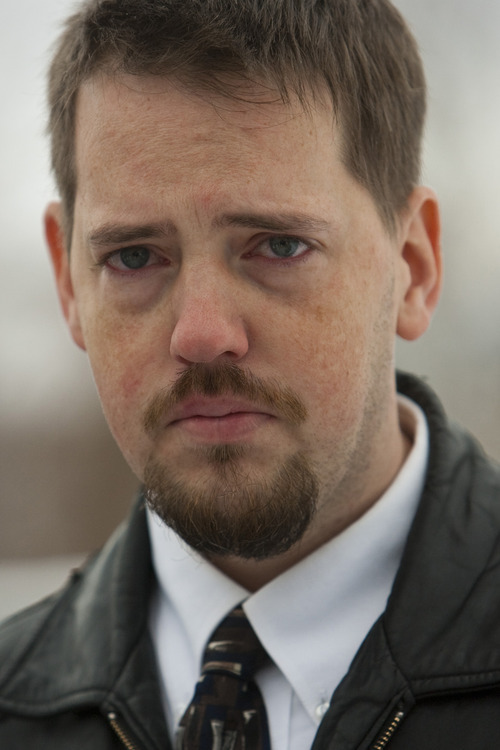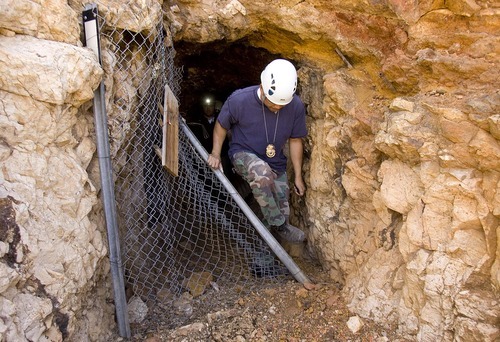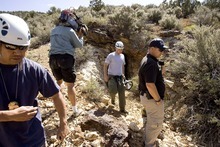This is an archived article that was published on sltrib.com in 2012, and information in the article may be outdated. It is provided only for personal research purposes and may not be reprinted.
At the time, it just seemed like one of those typical small-talk office party conversations.
But a year later, after Susan Powell disappeared, Scott Hardman had second thoughts about that conversation with Josh Powell. His recollections may have helped shape the West Valley City Police Department's two publicly announced searches for the still-missing woman in Utah's West Desert and near Ely, Nev.
Hardman said he knew Powell because their wives worked together at Fidelity Investments and at Wells Fargo Bank and had become friends. He'd met Powell several times at work-related get-togethers and had learned Powell wanted to debate everything.
"He was the type of individual that I would visit with if I had to," Hardman said. "There was always something that didn't feel right about him."
The conversation at their wives' work-related Christmas party in December 2008 was a typical example. Hardman, Powell and one of their wives' co-workers were discussing different crime investigation shows.
"We were discussing if you were to dispose of a body, how would you do it," he said.
Hardman, who wasn't into the CSI-style shows, said he didn't know what he would do. But Powell, who was into the crime dramas, had an answer.
"He brought up that a mine shaft was the best," Hardman said. "He said that if you knocked a little [of a shaft] loose, it would all come tumbling down and no one would really want to travel down it because they are all so unsafe."
Powell added that abandoned mine shafts are all over Utah's West Desert, Hardman said.
"He was always really interested in those, I guess," Hardman said.
Hardman said he didn't know what to think about Powell's comment at the time.
"It seemed he was taking satisfaction in getting that out there," he said.
When Susan Powell disappeared from the West Valley City home she shared with her husband and their two sons in December 2009, Hardman felt shocked. He later recounted the conversation with Josh Powell to police.
It is well-known that Utah is riddled with abandoned mines. According to Chris Rohrer, senior reclamation specialist for the Utah Abandoned Mine Reclamation Program, there is no comprehensive inventory of abandoned mines in the state. But the "working estimate" of the number ranges from 15,000 to 20,000.
Since 1982, the state has sealed — with backfill, concrete plugs or grates — about 6,000 of those mines, closing on average about 250 mines a year.
In March 2009, for example, it held a public meeting to discuss sealing 220 abandoned mines in Juab, Utah and Tooele counties, work that began later that fall. This summer and fall, it will tackle an additional 195 hard rock mine openings in Tooele County.
Mines that are highly unstable, close to population and recreation areas and accessible from roads get priority.
Rohrer estimates that roughly one-third of the remaining abandoned mines — with room for error and depending on what qualifies as a mine — are in the West Desert.
Some are hundreds of feet deep; others extend hundreds of feet into mountains. And as Powell apparently knew, many have unstable roofs and sides that could give way with little provocation.
Twelve people have died since the 1950s after falling into mines, being exposed to toxic gas or because of an explosion while working to close an abandoned mine, according to a list compiled by Mojave Underground, a group of mine explorers who preserve and restore historic sites.
An additional 24 people have been injured or trapped, according to Jim Springer, spokesman for the Utah Division of Oil, Gas and Mining. He said the most recent fatality occurred in 1999 near Sevenmile Pass in Tooele County, when a 26-year-old American Fork man crested a hill and drove into a 50-foot mine shaft.
Before sealing an abandoned mine, engineers work with archaeologists and biologists. The biologists do two assessments, one in the spring and one in the winter, to determine whether the shaft is used as a bat habitat.
That inspection is more difficult, if not impossible, with deep, vertical mines, Rohrer said, though sometimes cameras are used.
The assessments potentially could detect human remains, if they were not purposefully buried or covered with debris.
West Valley City Police contacted the division shortly after Susan Powell disappeared and some staff members initially assisted investigators, but "I don't think anything has transpired since then," Springer said.
Law-enforcement personnel have conducted two known searches in abandoned mine areas, one near Ely last August and another near Topaz Mountain in Utah's West Desert last September.
Members of the Gem and Mineral Club in Puyallup, Wash., which Powell attended with his sons, claimed police organized the Ely search after learning about a rock he'd been overly interested in.
Police also had a copy of a map Steve Powell sketched that illustrated his theory that Steve Koecher, who has been missing since Dec. 13, 2009, and traveled through the West Desert and Ely areas, might have run off with his daughter-in-law.
The second search came two weeks after law enforcement removed computers and other items from the Puyallup, Wash., home Powell shared with his father, Steve. Items taken from the home later led to Steve Powell's 2010 arrest on allegations of voyeurism and possession of child pornography. Earlier this year, Josh Powell killed his sons and committed suicide in a gasoline-fueled blaze he set at his Graham, Wash.-area rental home.
Stuart Burgess, co-founder of Mojave Underground, said in a post in a forum on his site that members have conducted three "dedicated" volunteer searches of mines in the Tintic mountains, West Tintics and the Dugway Range and found nothing. Another member said in a post two weeks ago that "between the official and unofficial searches and the MU exploring, I'm very confident every mine has been checked."
Members searched "every one that we know about and that's open," Burgess said. "We've covered a lot."
Only one mine left a question in his mind, one that the group publicly announced would be searched the weekend of June 25-26, 2010. When they arrived, they discovered someone had poured gasoline down the 300-foot-deep shaft and also set fire to the wooden supports at the surface. It was still smoldering and they had to call off the exploration.
"It buried anything down there and created a death trap because of the carbon monoxide generated by burning material," he said.
Burgess said he was able to rappel 260 feet into the shaft more than a year later and estimates there was 50 feet of debris covering the original bottom.
"I don't know if it was a coincidence or what, but that is the first time it's ever happened to me and I've easily been in 2,000 to 3,000 mines," he said.









